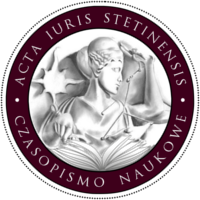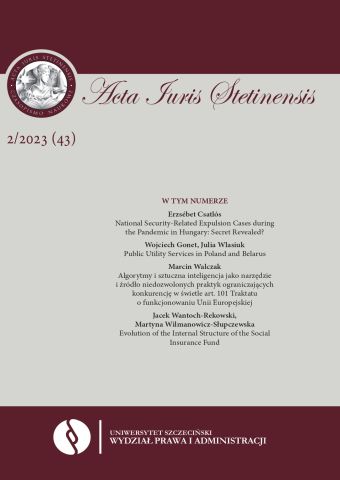






| Authors: |
Marcin
Walczak

Uniwersytet Szczeciński |
| Keywords: | algorithms; artificial intelligence; anticompetitive practices; EU antitrust law |
| Data publikacji całości: | 2023 |
| Page range: | 21 (123-143) |
| Downloads ?: | 122 |
| 1. | Blockx J., Antitrust in Digital Markets in the EU: Policing Price Bots, Radboud Economic Law Conference 9 June 2017, https://ssrn.com/abstract=2987705. |
| 2. | Calvano E., Calzolari G., Denicolõ V., Pastorello S., 11.12.2019 r., Artificial Intelligence, Algorithmic Pricing and Collusion, https://ssrn.com/abstract=3304991. |
| 3. | Capobianco A., Gonzaga P., Algorithms and Competition: Friends or Foes?, 14.07.2017 r., CPI Antitrust Chronicle, www.competitionpolicyinternational.com/algorithms--and-competition-friends-or-foes. |
| 4. | Crandall J.W., Oudah M., Tennom, Ishowo-Oloko F., Abdallah S., Bonnefon J-F., Cebrian M., Shariff A., Goodrich M.A., Rahwan I., Cooperating with machines, „Nature Communications” 2018, nr 9, DOI: 10.1038/s41467-017-02597-8. |
| 5. | Deng A., An Antitrust Lawyer’s Guide to Machine Learning, „Antitrust” 2018, Vol. 32, No. 2. |
| 6. | Deng A., When Machines Learn to Collude: Lessons from a Recent Research Study on Artificial Intelligence, 30.08.2017 r., https://ssrn.com/abstract=3029662. |
| 7. | Derdak M.K., Czy androidy śnią o zmowach cenowych? Algorytmy cenowe, sztuczna inteligencja i prawo konkurencji, „Internetowy Kwartalnik Antymonopolowy i Regulacyjny” 2018, nr 8 (7). |
| 8. | Ezrachi A., Stucke M.E., Artificial Intelligence & Collusion: When Computers Inhibit Competition, „University of Illinois Law Review” 2017, nr 5. |
| 9. | Ezrachi A., Stucke M.E., Virtual Competition, „Journal of European Competition Law & Practice” 2016, Vol. 7, No. 9, DOI:10.1093/jeclap/lpw083. |
| 10. | Gnirke K., Unternehmensberatung soll Renault und Peugeot bei Preisabsprachen geholfen haben, „Der Spiegel”, 31.05.2018 r., www.spiegel.de/auto/aktuell/accenture-verhalfrenault-und-psa-zu-milliardengewinn-bei-ersatzteilen-a-1210152.html. |
| 11. | Ittoo A., Petit N., Algorithmic Pricing Agents and Tacit Collusion: A Technological Perspective, w: H. Jacquemin, A. De Streel (red.), L’intelligence artificielle et le droit, Bruxelles, Larcier 2017. |
| 12. | Jurkowska-Gomułka A., Materna G., Miąsik D., Art. 101, w: K. Kowalik-Bańczyk, M. Szwarc-Kuczer, A. Wróbel (red.), Traktat o funkcjonowaniu Unii Europejskiej. Komentarz. Tom II (art. 90–222), Warszawa 2012, https://sip.lex.pl/#/commentary/ 587648062/445502. |
| 13. | Komisja Europejska, Komunikat Komisji do Parlamentu Europejskiego, Rady Europejskiej, Europejskiego Komitetu Ekonomiczno-Społecznego i Komitetu Regionów Sztuczna inteligencja dla Europy COM/2018/237 final z 25 kwietnia 2018 r., https://eur-lex.europa.eu/legal-content/PL/TXT/?uri=CELEX%3A52018DC0237. |
| 14. | Komisja Europejska, Sprawozdanie Komisji dla Parlamentu Europejskiego, Rady, Europejskiego Komitetu Ekonomiczno-Społecznego i Komitetu Regionów. Sprawozdanie dotyczące polityki konkurencji za rok 2018 COM(2019) 339 final z 15 lipca 2019 r., https://eur-lex.europa.eu/legal-content/PL/TXT/PDF/?uri=CELEX:52019DC0339&from=pl. |
| 15. | Komisja Europejska, Sprawozdanie Komisji dla Rady i Parlamentu Europejskiego. Sprawozdanie końcowe na temat badania sektora handlu elektronicznego COM/2017/0229 final z 10 maja 2017 r., https://eur-lex.europa.eu/legal-content/PL/TXT/PDF/?uri-=CELEX:52017DC0229&from=pl. |
| 16. | Maziarz A., Pojęcie uzgodnionej praktyki w świetle art. 101 Traktatu o funkcjonowaniu Unii Europejskiej, „Palestra” 2013, nr 58/1–2 (661–662). |
| 17. | McLennan M., Whish urges restraint on algorithmic collusion, 5.07.2017 r., Global Competition Review, https://globalcompetitionreview.com/article/1144015/whish-urges--restraint-on-algorithmic-collusion. |
| 18. | Ministerstwo Cyfryzacji, Założenia do strategii AI w Polsce, Warszawa 2018, www.gov.pl/web/cyfryzacja/ai. |
| 19. | OECD, Algorithms and Collusion: Competition Policy in the Digital Age, 14.09.2017 r.,www.oecd.org/competition/algorithms-collusion-competition-policy-in-thedigital-age.htm. |
| 20. | Petit N., Antitrust and Artificial Intelligence: A Research Agenda, „Journal of EuropeanCompetition Law & Practice” 2017, Vol. 8, Issue 6. |